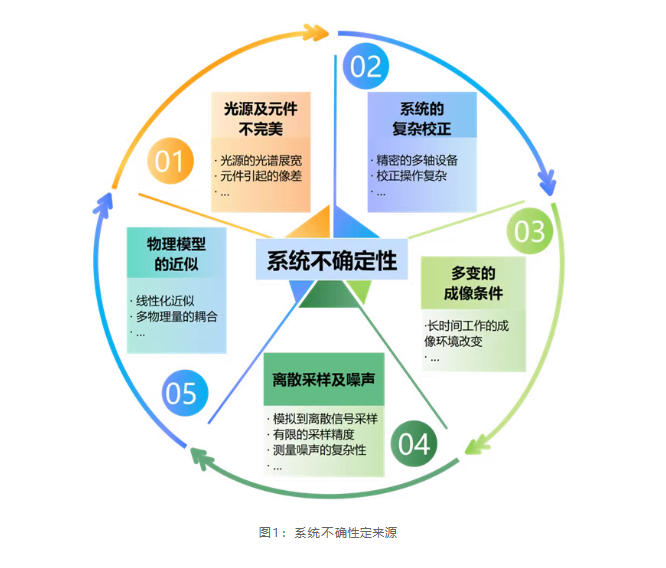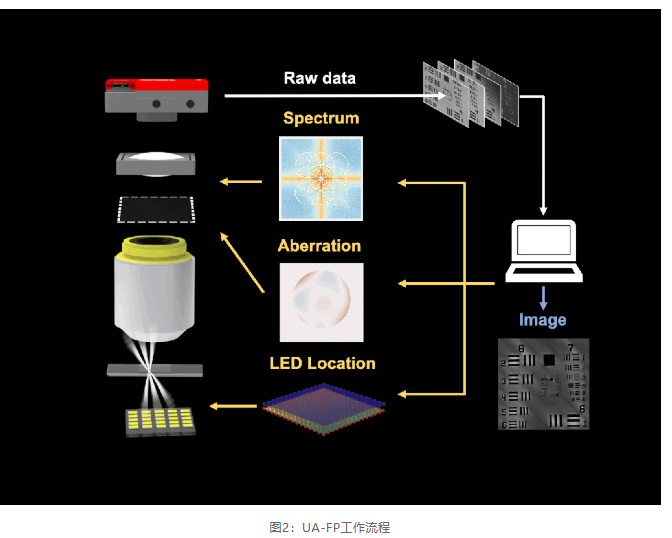20
2025
-
08
Differentiable imaging unlocks full-link optimization
Author:
In the field of computational imaging, uncertainty has long constrained technological development. To break through the shackles of traditional technology, the ISL laboratory at the University of Hong Kong, led by Professor Edmund Y. Lam, collaborated with research teams from Sichuan University and Tsinghua University to tackle challenges together, successfully developing the Uncertainty-Aware Fourier Ptychography (UA-FP) technology. This technology utilizes differentiable programming to simultaneously construct various system uncertainty models, freeing itself from the dependence on complex calibration. In the face of system misalignment, optical aberrations, or low-quality data, it can simultaneously optimize image content and system parameters, achieving high-quality reconstruction and significantly improving imaging accuracy. With its innovative uncertainty management strategy, UA-FP has achieved important technological breakthroughs in fields such as biological imaging, remote sensing, and semiconductor inspection.
In the wave of modern imaging technology development, computational imaging, with its unique model of joint design of optical systems and algorithms, has completely overturned traditional imaging concepts and has become a crucial part of the modern imaging technology system. Fourier Ptychography, as a classic technology in computational imaging, has shone brightly in many fields such as high-precision microscopic imaging in materials science, phase imaging of biological tissue samples, and synthetic aperture imaging in remote sensing, thanks to its powerful multi-scenario cross-scale adaptability.
Technical Difficulties and Challenges
However, the field of computational imaging has long faced a tricky common problem—system uncertainty, and Fourier Ptychography is no exception. From the imperfections of optical sources and components to the limitations of the system calibration environment; from the complex and variable imaging conditions to the interference of camera discretization characteristics and noise, even the limitations of human understanding of physical principles have become sources of uncertainty. These factors intertwine, leading to system misalignment, optical aberrations, and significantly reduced data quality, resulting in deviations between the physical system and mathematical models, severely restricting imaging performance and the development of the entire computational imaging field. Traditional independent technologies such as manual calibration, aberration correction, and noise reduction, while each playing a certain role, not only increase system complexity but also struggle to cope with the interactions of various uncertainty factors.

To break through the shackles of traditional technology, researchers have successfully developed the Uncertainty-Aware Fourier Ptychography technology. This technology relies on cutting-edge differentiable computational imaging paradigms, innovatively achieving synchronous modeling and optimization of system uncertainty, completely overturning the inherent limitations of traditional imaging technology. Without relying on precise calibration processes and high-end optical components, UA-FP can still significantly improve image reconstruction quality, opening up a new technological path for the field of computational imaging.
Research Highlights
The core advantage of the Uncertainty-Aware Fourier Ptychography technology lies in the construction of a globally differentiable imaging model. This model parameterizes various uncertainty factors such as system misalignment, optical aberrations, and data quality, integrating them into the same optimization framework for comprehensive consideration, achieving synchronous modeling of multiple uncertainties, thereby ensuring that the imaging system can still operate stably under complex environmental conditions.
At the same time, the Uncertainty-Aware Fourier Ptychography technology has established a self-calibrating feedback loop mechanism, which can intelligently switch between image content optimization and system parameter optimization, continuously improving image reconstruction quality through an automated iterative process, greatly enhancing the autonomy and accuracy of the imaging process. The deep application of automatic differentiation technology endows this technology with powerful optimization flexibility, allowing it to dynamically adjust and optimize various loss functions and regularization terms according to different imaging needs, completely breaking through the limitations of fixed loss functions in traditional imaging algorithms.
Experimental results fully validate the outstanding performance of the Uncertainty-Aware Fourier Ptychography technology. Even when using low-cost hardware devices and without fine calibration, this technology can still effectively correct system misalignment and optical aberration issues, reconstructing high-quality images from low-quality raw data. In the face of complex situations such as system misalignment, optical aberrations, and poor sensor data quality, this technology demonstrates strong environmental adaptability, capable of consistently outputting high-quality image reconstruction results. Furthermore, the Uncertainty-Aware Fourier Ptychography technology has relaxed the stringent requirements on sub-spectral overlap in traditional Fourier Ptychography algorithms and achieved resolution breakthroughs beyond the physical diffraction limit through computational spectral expansion, bringing new possibilities for the development of imaging technology.
More importantly, the Uncertainty-Aware Fourier Ptychography technology can effectively separate the errors caused by the defects of optical components themselves and system misalignment. This characteristic makes it promising to expand the application fields of Fourier Ptychography systems from traditional image acquisition to the detection and evaluation of optical components, providing new directions for technological development in related fields.

Application Prospects and Future Outlook
Currently, the UA-FP technology demonstrates its strong technical strength in the field of Fourier Ptychography microscopy, but this is just its preliminary display. With its unique advantages in accurately handling various system uncertainties and achieving super-resolution imaging, the UA-FP technology is expected to achieve significant breakthroughs in multiple fields. In the semiconductor inspection field, it can precisely detect small defects with high resolution and strong system error correction capabilities, improving product quality control levels; electronic stacking photography faces complex imaging challenges in electronic optical systems, and the advantages of UA-FP technology in addressing optical aberrations and data quality issues give it the potential to solve these problems; in large-scale FP applications, this technology relaxes the requirements for sub-spectral overlap and expands computational spectral capabilities, effectively improving imaging efficiency and quality, opening up broader application spaces.
Computational imaging has long been troubled by issues such as system misalignment, optical aberrations, and poor data quality, which severely hinder the development and application of imaging technology. The UA-FP technology precisely targets these pain points, effectively addressing related issues through an innovative synchronous modeling and optimization mechanism for uncertainty. Therefore, the UA-FP technology is highly likely to develop into a universal uncertainty management framework, providing strong technical support for many cutting-edge fields such as biological imaging, remote sensing, and space imaging.
The success of the UA-FP technology is backed by the research team's exploration and in-depth study of differentiable imaging that began in 2021. 1]、[2 Differentiable imaging is built on a solid foundation of differentiable programming, cleverly constructing the imaging process into a differentiable computational graph, achieving full-link optimization from the physical encoding stage to the computational decoding stage. The research team has explored and practically verified this technology in multiple research directions such as differentiable holography, 3 differentiable superpixel resolution lensless imaging, 4 and differentiable high-density three-dimensional particle tracking, 5 fully demonstrating its excellence.
The powerful capabilities demonstrated by differentiable imaging are largely attributed to differentiable programming. As Yann LeCun stated on Facebook: "Deep Learning est mort. Vive Differentiable Programming!" (Deep learning is dead, differentiable programming lives on!) — this striking declaration precisely reveals the essence of technological development. Differentiable programming, as a broader programming paradigm, is built on the solid foundation of automatic differentiation. Deep learning can be seen as a specific application of differentiable programming in the field of artificial intelligence. In this technological lineage, the pioneering contributors to backpropagation automatic differentiation have respectively won the 2018 Turing Award and the 2024 Nobel Prize in Physics — the crowning of these two international top honors not only highly recognizes the theoretical value of differentiable programming but also confirms its irreplaceable importance in promoting scientific and technological progress.
Today, differentiable imaging technology based on differentiable programming has become a key force in the field of computational imaging. The value of differentiable imaging technology far exceeds the scope of uncertainty perception computing; its core significance lies in constructing a multidimensional fusion ecosystem in the field of computational imaging: it breaks the boundaries between hardware design and software reconstruction, achieving seamless collaboration between the device side and the algorithm side; it integrates numerical optimization and machine learning, continuously driving the iterative upgrade of algorithm performance; it deeply couples mathematical theory, information theory, and physical implementation, transforming abstract concepts into practical technical solutions; it further promotes the interdisciplinary integration of optics, materials science, and computing, completely eliminating technical barriers between disciplines. Under the connection of this technology, key modules of computational imaging have formed a virtuous cycle of collaborative evolution, successfully tackling the industry challenge of end-to-end optimization. Currently, differentiable imaging is reshaping the landscape of the computational imaging industry with disruptive innovation. With its unique technical architecture, this technology not only provides a clear technical path for the integration of digital twins and imaging technology. 2 It also opens up a new dimension for the development of AI + Science in the field of imaging. Looking ahead, with the continuous evolution of technology, differentiable imaging is expected to continuously break through in basic scientific research and industrial applications, giving rise to more transformative innovative results and unlocking unlimited potential for development in various fields.
LATEST NEWS
2025-12-17
Beijing Institute of Technology Review: Infrared Detectors for In-Memory Sensing and Computing
2025-12-17
High-performance III-V family infrared detectors
Since the advent of infrared detectors in the 1940s, their technological framework has undergone leapfrog development, with significant expansions in both device types and performance.

